|

On eBay Now...
Diamond Ring Black Hills 12kt Red Green Gold Leaf Diamond: Ancient Minoan Crete For Sale
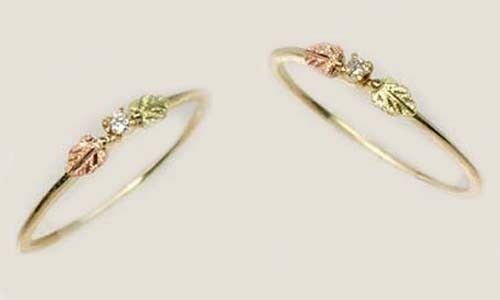
When you click on links to various merchants on this site and make a purchase, this can result in this site earning a commission. Affiliate programs and affiliations include, but are not limited to, the eBay Partner Network.

Diamond Ring Black Hills 12kt Red Green Gold Leaf Diamond: Ancient Minoan Crete:
$249.99
Genuine Handcrafted “South Dakota Black Hills” Solid Gold Ring Featuring Red and Green Colored Leaves and a Genuine 1.6mm Diamond. Size 7 (resizing available). Not cheap gold electroplate! This is a high-quality, handcrafted ring. The ring itself is 10kt solid gold, the handcrafted rose and leaves are 12kt solid gold. NOTE: We can send the ring out for resizing (incurs nominal extra cost). DESCRIPTION: The art of fashioning gold jewelry reached the Mediterranean island of Crete (home of the ancient Minoans) about 2400 B.C. Diadems, hair ornaments, beads, bracelets, and complex chains have been found in Minoan tombs. Near Eastern techniques of filigree and granulation were introduced to Crete about 2000 B.C., and evidence also indicates that Egyptian styles influenced Minoan jewelry. Minoan culture and its jewelry styles spread to the mainland of Greece, then dominated by the city-state of Mycenea, about 1550 B.C. The graves of nobles at the ancient Citadel of Mycenae discovered by Heinrich Schliemann in 1876 likewise yielded a great variety of gold figurines, masks, cups, diadems, and jewelry, plus hundreds of decorated beads and buttons. These elegant works of art were created by skilled craftsmen more than 3,500 years ago. In celebration of that heritage here is a gorgeous, high quality 10/12kt solid gold ring. Please do not confuse this with cheap gold electroplate. This is a high-quality, hand-made ring, crafted right here in the USA, and constructed to last a lifetime. The ring itself is constructed of 10kt solid gold, while the handmade red and green colored leaves are constructed of solid 12kt gold. This style of handcrafted multi-colored gold jewelry originated in the Black Hills of South Dakota. The leaf, rose (and frequently grape) designs incorporated into this style of gold jewelry was inspired by wild grape vines and wild roses that flourish in the region. Set into the center of the ring, between the two flanking leaves, is a very nice quality white diamond, 1.6mm (approximately 0.01 carats). Though we\'re not trying to intimate that the diamond accent is absolutely flawless, to the eye at least the gemstone is clean and without discernible blemish. HISTORY OF GOLD: From the earliest of times, gold was often held in awe as the symbol of divinity and was therefore the material of choice for religious objects. Gold was among the first metals to be mined because it commonly occurs in pure form (not combined with other elements), because it is beautiful and imperishable, and because exquisite objects can be made from it. Since gold is found uncombined in nature, early goldsmiths would collect small nuggets of gold from stream beds etc., and then weld them together by hammering. It was oftentimes discovered alloyed with 10%-20% silver, the mixture known as “electrum”. Gold was \"discovered\" well before 6,000 B.C., most likely in Mesopotamia, though some of the oldest gold objects made by mankind were discovered by archaeologists in present-day Bulgaria (ancient Thrace) and in the Balkans, such as at the Varna Necropolis. In ancient Egypt all gold was the property of the pharaoh. Artifacts and jewelry of gold over 5,000 years old have been uncovered by archaeologists in Egyptian tombs. Around 3,600 B.C. Egyptian goldsmiths carried out the first smelting of ores using blowpipes made from fire-resistant clay to heat the smelting furnace. Ancient Egyptian hieroglyphs describe gold as the brilliance of the sun. In the Near East, by 2,500 B.C., Sumerian goldsmiths were using sophisticated metalworking techniques; cold hammering, casting, soldering, cloisonné, and particularly filigree (fine-wire ornamentation) and granulation (the use of minute drops of gold). The tomb of the Sumerian Queen Puabi, from the city of Ur in about the 26th century B.C., was one of the richest tombs ever uncovered by archaeologists. Queen Puabi was buried with five soldiers and thirteen \"ladies in waiting\" who had apparently poisoned themselves (or been poisoned) to serve their mistress in the next world. The grave goods she was buried with included a magnificent, heavy, gold headdress made of golden leaves, rings, and plates; a superb lyre complete with a gold and lapis-lazuli encrusted bearded bulls head; a profusion of gold tablewear; cylindrical beads of gold, carnelian, and lapis lazuli woven into extravagant necklaces and belts; a chariot adorned with lioness\' heads in silver, and an abundance of silver, lapis lazuli, and gold rings and bracelets. Another of the most famous tombs uncovered by archaeologists was that of 14th century B.C. Tutankhamun. The pharaohs of Egypt insisted on being buried in gold, which they believed was the \"flesh of the gods.\" The boy-king Tutankhamun was enshrined in three gold coffins. The third and final coffin was made of 243 pounds (110 kilograms) of solid gold. As well, gold artifacts and jewelry abounded, including the solid gold mask which weighed 10 kilos (24 pounds). It’s worth noting that Tutankhamun was a minor, almost unknown and forgotten pharaoh. One can only imagine the wealth of gold some of ancient Egypt’s more significant pharaohs (such as Ramses the Great) must have been buried with. The art of fashioning gold jewelry reached the Mediterranean island of Crete (the ancient Minoans) about 2400 B.C. Diadems, hair ornaments, beads, bracelets, and complex chains have been found in Minoan tombs. Near Eastern techniques of filigree and granulation were introduced to Crete about 2000 B.C., and evidence also indicates that Egyptian styles influenced Minoan jewelry. Minoan culture and its jewelry styles spread to the mainland of Greece, then dominated by the city-state of Mycenea, about 1550 B.C. The graves of nobles at the ancient Citadel of Mycenae discovered by Heinrich Schliemann in 1876 likewise yielded a great variety of gold figurines, masks, cups, diadems, and jewelry, plus hundreds of decorated beads and buttons. These elegant works of art were created by skilled craftsmen more than 3,500 years ago. Metalworking techniques reached northern Europe by about 2000 B.C., and the earliest jewelry found there dates from between 1800 and 1400 B.C. These artifacts include lunulae (spectacular, crescent-shaped neck ornaments of beaten gold), most of which were found in graves in Ireland, where gold was once plentiful. There is evidence that the Celtic and early British people were trading with the Eastern Mediterranean races by this time, exchanging gold for faience beads. By 1200 B.C. jewelry making was flourishing in Central and Western Europe, where bronze as well as gold was frequently used to make jewelry, and the spiral was the most common motif of decoration. The fibula-brooch seems to have been invented at about this time. Twisted gold torcs, modeled on Scandinavian bronze prototypes, were made in the British Isles and northern France from the fifth to the first century B.C. These massive circlets for the necks and arms were the characteristic ornaments of the chiefs of the Celtic race, and were symbols of wealth, power and courage across Celtic Europe. Celtic craftsmen also used enamel and inlay to decorate jewelry. By the seventh century B.C. the Etruscans of Central Italy were also making fine gold jewelry. These people may have migrated from Anatolia (present-day Turkey), from where their metalworking skills seem to have been derived. The Etruscans brought to perfection the difficult technique of granulation, whereby the surface of the metal is covered with tiny gold grains. Gold was plentiful in Greece during the Hellenistic Age (323-30 B.C.), and Greek jewelry of this period is characterized by its great variety of forms and fine workmanship. Naturalistic wreaths and diadems were made for the head, and a variety of miniature human, animal, and plant forms were made up into necklaces and earrings. The so-called Heracles-knot, of amuletic origin, was introduced, and remained a popular motif into Roman times. The ancient Mediterranean civilizations appear to have obtained most their supplies of gold from various deposits in the Middle East, as well as gold which came through the Middle East from Southern Africa, and perhaps a minor amount from the Ural Mountains. Mines in the region of the Upper Nile (south of Egypt) near the Red Sea and in the Nubian Desert area supplied much of the gold used by the Egyptian Pharaohs (the area was known to the ancient Egyptians as “Punt”, and to the ancient Christians as “Sheba” or “Saba”). When these mines could no longer meet Egypt’s demand for gold, deposits elsewhere were exploited, likely including deposits thousands of miles away in Southern Africa. Archaeological evidence indicates that most of the gold in Ancient Egypt and even in the ancient Mediterranean from perhaps 1700 B.C. onwards came from the Himyarites in present-day Yemen (across the Red Sea from Nubia), who in addition to exploiting their own deposits, may in turn have obtained much of the gold they exported to the ancient Egyptians from present day Rhodesia/Zimbabwe. In fact the Himyarites likely controlled most of the east coast of Africa, including Rhodesia/Zimbabwe, and is most likely the area referred to as Monomotapa in ancient texts (known also as the Biblical city of Ophir, from which the Bible records that King Solomon received shipments of gold, silver, ivory, gemstones, and peacocks). Artisans in Mesopotamia and Palestine probably obtained their supplies either directly from the Himyarites or indirectly through (middleman) Egypt. As well, recent studies of the ancient mines in the present Kingdom of Saudi Arabia (directly to the north of Yemen) reveal that gold, silver, and copper were recovered from the Red Sea region, across the Red Sea from the Nubian deposits, during the reign of King Solomon (961-922 B.C.). Around 1500 B.C. artisans of the ancient world developed the “lost wax” method of producing jewelry, allowing for the “mass production” of gold jewelry. At the same time, gold had already become the recognized medium of exchange for international trade. The sixth century B.C. saw the first use of gold in dentistry by the ancient Egyptians, and the introduction of the first gold coinage in Asia Minor by King Croesus of Lydia. By this time, much of the gold in the Classical Mediterranean cultures came from Spain, where extensive deposits of gold and silver were mined and then acquired by the ancient Phoenicians in trade, and then brought from the Western Mediterranean and traded through the ancient Mediterranean world. Eventually the Phoenician colony of Carthage became the leading power of the Eastern Mediterranean, and gained control over these valuable Spanish deposits. In turn the Carthaginians engaged the Romans in three wars before Spain was lost to the Romans. Spanish gold and silver to a great extent allowed the Romans to expand their empire. The “other” great power of the Classical Mediterranean were the Hellenic Greeks, who by 325 B.C. were mining gold from Gibraltar to Asia Minor. When the gold in Spain began to play out, the Romans turned their attention toward the gold mines in Dacia (modern Romania). The Dacians had historically traded this gold to the Greeks for pottery and to the Scythians for amber. About 100 A.D. the Roman Emperor Trajan conquered Dacia, mainly in order to gain control of these gold mines. The Romans also exploited smaller gold deposits found in the British Isles. The Romans used very sophisticated extraction and mining techniques as detailed by the first-century historian and naturalist Pliny the Elder. The Romans were also the first to mass-produce coinage on a monumental scale, the first truly monetized society. Between the second and fourth centuries A.D., the Romans produced millions of gold aureus coins, and billions of silver and bronze coins. At the height of the Roman Empire, there were over 400 mints producing coinage in locations scattered through their dominion. Gold was fashioned into Greek style jewelry during the early Roman Empire, when the chief centers of production were Alexandria, Antioch, and Rome, to which Greek craftsmen had migrated. There was an increasing emphasis in producing gold jewelry on incorporating decorative stones; at first garnets, chalcedonies, and carnelians, but later uncut but polished hard gemstones such as diamonds, sapphires, and, notably, emeralds from “Cleopatra’s Mines” in Egypt. Colorful gemstone jewelry was common during the Early Middle Ages in the centuries immediately following the collapse of the Roman Empire. Mediterranean goldsmiths continued to produce jewelry of great refinement, but the jewelry of the European Celtic tribes dominated this period. They produced abstract styles of great splendor which were worked in enamels and inlaid stones. The fibula-brooch reached extremes of size and elaboration. During the High Middle Ages the technique of cloisonné enameling on gold was widespread, the finest pieces emanating from the workshops at Constantinople, the capital of the Byzantine Empire. After the creation of Charlemagne\'s empire in 800 A.D. and the Holy Roman Empire in 962 A.D., a fusion of northern and Mediterranean cultures occurred. The principal patrons of the arts became the emperor and the church, and jewelers worked in courts and monasteries. Jewelry design was based on the setting in gold of precious stones and pearls in colorful patterns. Gold was used widely for crosses, altars, doors, chalices, and reliquaries. This association with divinity naturally developed into an association with royalty. Even in modern times the accoutrements of royalty are predominantly gold. However there was a critical shortage of gold which developed in the High Middle Ages. During the years 1370-1420 A.D. as various major mines around Europe become completely exhausted. Mining and production of gold declined sharply throughout the region in a period known as \'The Great Bullion Famine\'. However by about 1433 A.D. this spurred the Portuguese to start sailing to Ghana in Western Africa and thus enabling them to trade for gold without having to cross the Sahara Desert into Muslim northern Africa. By 1471 A.D., the Portuguese were even calling West Africa the \"Gold Coast\", and a reliable source of gold was again available to Western Europe. In the “New World”, archaeologists believe that the gold in the Aztec and Inca treasuries of Mexico and Peru came from Colombia, although some undoubtedly was obtained from other sources. The Aztecs regarded gold as literally the product of the gods, calling it \"god excrement\". The Conquistadores plundered the treasuries of these civilizations during their explorations of the New World, and many gold and silver objects were melted and re-cast into coins and bars, destroying the priceless artifacts of these MesoAmerican cultures. Gold is widely dispersed through the earth\'s crust (and even in seawater) and is found in two types of deposits; lode deposits, which are found in solid rock and are mined using conventional mining techniques, and placer deposits which are gravelly deposits found in stream beds and are the products of eroding lode deposits. The largest gold nugget ever found was in 19th century Australia weighing over 70 kilograms (150 pounds). Gold is quite unique in its malleability. No other metal compares with it. A single ounce can be stretched into a wire 60 kilometers long (40 miles), or pounded into a sheet of 300 square feet (the size of two typical suburban bedrooms). Because of its chemical inertness, gold retains its brilliant color even after centuries of exposure to corrosive elements. The most workable of all metals, gold has been forged, chased, embossed, engraved, inlayed, cast, and in the form of gold leaf, used to gild metals, woods, leather, and parchment. Gold wire has found wide uses in brocades and ornamentation of other materials. Throughout at least five millennia of recorded history it has been used to fashion sculpture, vessels, jewelry, ornamentation, and coinage. Throughout the history of the ancient world, gemstones were believed capable of curing illness, possessed of valuable metaphysical properties, and to provide protection. Found in Egypt dated 1500 B. C., the \"Papyrus Ebers\" offered one of most complete therapeutic manuscripts containing prescriptions using gemstones and minerals. Gemstones were not only valued for their medicinal and protective properties, but also for educational and spiritual enhancement. In the ancient world, gold was regarded to symbolize power, strength, wealth, warmth, happiness, love, hope, optimism, intelligence, perfection, summer, harvest and the sun. Gold was also believed to possess curative and “magical” properties. During justice, balance, the Middle Ages it was believed that something as rare and beautiful as gold could not be anything but healthy, so gold was regarded as beneficial for health and was not only worn but also ingested. In fact, some gold salts do have anti-inflammatory properties, and in modern times, injectable gold has been proven to help to reduce the pain and swelling of rheumatoid arthritis and tuberculosis. The isotope gold-198 is also used in some cancer treatments and for treating other diseases. Gold flake was used by the nobility in Medieval Europe as a decoration in food and drinks, in the form of leaf, flakes or dust, either to demonstrate the host\'s wealth or in the belief that something that valuable and rare must be beneficial for one\'s health. Even today gold leaf, flake or dust is used on and in some gourmet foods, notably sweets (particularly in India and the Middle East) and drinks as decorative ingredient. DIAMOND HISTORY: In the ancient world there was only one source of diamonds…India. Bombay remains today one of the world’s great diamond cutting centers (along with New York, Tel Aviv, and Antwerp). Over 800,000 cutters are employed in the city of Bombay alone; cutting 90% of the world’s diamonds. The best Indian diamonds originated from the Majhgawan pipe, near Panna, India, which was discovered in 1827. However India is no longer a big producer of mined diamonds, producing only about 20,000 carats a year. Australia produces 2,000 times more diamonds each year – about 40 million carats a year; followed by 20 million carats a year for the Congolese Republic, 15 million carats a year for Botswana, and 10 million carats a year each for Siberia and South Africa. However this region of India did produce some of the world’s greatest diamonds, including the Great Mogul (793 carats), the Regent (410 carats), the Nizam (340 carats), the Orloff (194 carats), the Kohinoor (132 carats), and the Hope or Blue Tavernier (112 carats). The traditional Indian supplies of diamonds which had fed the appetites of the ancient world for thousands of years were almost exhausted when enormous new alluvial deposits of diamonds were discovered in 1725 in Brazil, followed by the staggering discoveries of 1870 in South Africa. Perhaps the earliest symbolic use of diamonds was as the eyes of Hindu devotional statues. The diamonds themselves were thought to be endowments from the gods and were therefore cherished. The point at which diamonds assumed their divine status is not known, but early texts indicate they were recognized in India since at least 400 B.C. The word most generally used for diamond in Sanskrit was vajra, or \"thunderbolt,\" and the possession of diamond was according to ancient Hindu texts thought to bring, “happiness, prosperity, children, riches, grain, cows and meat. (As well) he who wears a diamond will see dangers recede from him whether he (is) threatened by serpents, fire, poison, sickness, thieves, flood or evil spirits.\" The ancient Greeks believed diamonds were tears of the gods; and it is from the Greek word adamas, \"untameable\" or \"unconquerable\", referring to its hardness, that the word “diamond” is derived. The ancient Romans believed that diamonds were splinters of fallen stars. The presence of diamond in Rome is established by the writings of Pliny the Elder (23-79 A.D.). Unfortunately according to Pliny, “these stones are tested upon the anvil, and will resist the blow to such an extent as to make the iron rebound and the very anvil split asunder.\" One can only imagine the numbers of genuine diamonds smashed into splinters by this ill-advised test. However even diamond splinters were valued by the Romans who used diamond points set into iron scribes to engrave sapphires, cameos, and intaglios. Even early Chinese references to diamond cite its coming from Rome in iron scribes. Chinese interest in diamond was strictly as an engraving or carving tool, primarily for jade, or as a drill for beads and pearls. In western culture, diamonds have been the traditional emblem of fearlessness and virtue. Though most of the world’s diamonds are cut in Bombay, over 90% of the world’s rough diamonds are traded in Antwerp, Belgium. Between the 13th and 15th centuries the world’s diamond center had been Bruges; then Antwerp until the city’s capture by the Spanish in 1585 A.D.; then Amsterdam through the early 19th century, then back to Antwerp. The Portuguese colony of Goa was the point of origin for diamonds from India, the trade route developing from Goa to Lisbon to Antwerp and thus cutting out the traditional Arabic middle men. Small numbers of diamonds begin appearing in European regalia and jewelry in the 13th century, set as accent points among pearls in splendidly wrought gold. Louis IX of France (1214-70 A.D.) decreed that diamonds were to be reserved for royalty alone, an indication of the rarity of diamonds and the value conferred on them at that time. The history of diamond cutting can be traced to the late Middle Ages, before which time diamonds were enjoyed in their natural octahedral state. At the time, diamond was valued chiefly for its brilliant lustre and superlative hardness. The most common (“table”) cut diamond would appear black to the eye, as they do in paintings of the era. Diamond cutting is believed to have originated in Venice about 1330 A.D. By 1375 A.D. there was a guild of diamond polishers in Nurnberg. About a hundred years later absolute symmetry in the disposition of faceting was introduced and the most common cuts were known as pendeloque or briolette. About the middle of the 16th century, the rose cut was introduced. The first “brilliant cut” was introduced in the middle of the 17th century. By the 16th century as diamonds became larger and more prominent, their popularity had spread from royalty to the noble classes. This was in part a response to the development of diamond faceting, which enhanced their brilliance and fire. By the 17th century diamonds were becoming popular with the wealthy merchant class. Diamonds occur in a variety of colors - steel, white, blue, yellow, orange, red, green, pink, brown and black. The most common diamonds, and arguably the most sought after (though not the rarest) are pure and colorless. The most common impurity is nitrogen, which if dispersed will give the stone a yellowish tint (but if clustered does not affect the diamond’s color). Diamonds without nitrogen impurities are often colored pink, red, or brown – the color arising from molecular structural anomalies. Blue diamonds are colored by boron impurities. A form of carbon, diamonds are not “forever”, even the Romans demonstrated that they will burn (or decay with heat). However a diamond is likely the oldest thing you will ever own, probably 3 billion years in age, fully two thirds the age of the Earth. Diamonds are carbon crystals that form deep within the Earth under high temperatures and extreme pressures. For instance when as part of “plate teutonics” an ocean floor slides beneath the earth’s crust and into the mantle, entrapped organic carbon may eventually become diamond. They are created at depths generally more than 150 kilometers down into the mantle. Diamonds are brought back to the surface in a rare form of molten rock (or magma), that originates at great depths, which rises and erupts in small but violent volcanoes. When cooled, just beneath such volcanoes is a carrot-shaped \"pipe\" filled with volcanic rock, mantle fragments, and embedded diamonds. Diamonds also form as a result of the immense pressures created by meteor impacts. Meteorites also experience impacts themselves and can contain diamonds. And the most ancient meteorite material contains star dust, the remnants of the death of stars. Some of this star dust are very small diamonds and are older than the solar system itself. New studies indicate that they formed more than 5 billion years ago in flashes of radiation from dying red-giant stars into surrounding clouds of methane-rich gas. If you would like to learn more about diamonds, please click here to visit a great web site by the American Museum of Natural History. SHIPPING & RETURNS/REFUNDS: Your purchase will ordinarily be shipped within 48 hours of payment. We package as well as anyone in the business, with lots of protective padding and containers. All of our shipments are fully insured against loss, and our shipping rates include the cost of this coverage (through stamps.com, Shipsaver.com, the USPS, UPS, or Fed-Ex). International tracking is provided free by the USPS for certain countries, other countries are at additional cost. ADDITIONAL PURCHASES do receive a VERY LARGE discount, typically about $5 per item so as to reward you for the economies of combined shipping/insurance costs. We do offer U.S. Postal Service Priority Mail, Registered Mail, and Express Mail for both international and domestic shipments, as well United Parcel Service (UPS) and Federal Express (Fed-Ex). Please ask for a rate quotation. We will accept whatever payment method you are most comfortable with. Please note for international purchasers we will do everything we can to minimize your liability for VAT and/or duties. But we cannot assume any responsibility or liability for whatever taxes or duties may be levied on your purchase by the country of your residence. If you don’t like the tax and duty schemes your government imposes, please complain to them. We have no ability to influence or moderate your country’s tax/duty schemes. If upon receipt of the item you are disappointed for any reason whatever, I offer a no questions asked 30-day return policy. Send it back, I will give you a complete refund of the purchase price; 1) less our original shipping/insurance costs, 2) less any non-refundable fees. Please note that though they generally do, may not always refund payment processing fees on returns beyond a 30-day purchase window. So except for shipping costs and any payment processing fees not refunded by , we will refund all proceeds from the sale of a return item. Obviously we have no ability to influence, modify or waive policies. ABOUT US: Prior to our retirement we used to travel to Eastern Europe and Central Asia several times a year seeking antique gemstones and jewelry from the globe’s most prolific gemstone producing and cutting centers. Most of the items we offer came from acquisitions we made in Eastern Europe, India, and from the Levant (Eastern Mediterranean/Near East) during these years from various institutions and dealers. Much of what we generate on Etsy, Amazon and goes to support worthy institutions in Europe and Asia connected with Anthropology and Archaeology. Though we have a collection of ancient coins numbering in the tens of thousands, our primary interests are ancient/antique jewelry and gemstones, a reflection of our academic backgrounds. Though perhaps difficult to find in the USA, in Eastern Europe and Central Asia antique gemstones are commonly dismounted from old, broken settings – the gold reused – the gemstones recut and reset. Before these gorgeous antique gemstones are recut, we try to acquire the best of them in their original, antique, hand-finished state – most of them originally crafted a century or more ago. We believe that the work created by these long-gone master artisans is worth protecting and preserving rather than destroying this heritage of antique gemstones by recutting the original work out of existence. That by preserving their work, in a sense, we are preserving their lives and the legacy they left for modern times. Far better to appreciate their craft than to destroy it with modern cutting. Not everyone agrees – fully 95% or more of the antique gemstones which come into these marketplaces are recut, and the heritage of the past lost. But if you agree with us that the past is worth protecting, and that past lives and the produce of those lives still matters today, consider buying an antique, hand cut, natural gemstone rather than one of the mass-produced machine cut (often synthetic or “lab produced”) gemstones which dominate the market today. We can set most any antique gemstone you purchase from us in your choice of styles and metals ranging from rings to pendants to earrings and bracelets; in sterling silver, 14kt solid gold, and 14kt gold fill. When you purchase from us, you can count on quick shipping and careful, secure packaging. We would be happy to provide you with a certificate/guarantee of authenticity for any item you purchase from us. There is a $3 fee for mailing under separate cover. I will always respond to every inquiry whether via email or message, so please feel free to write.

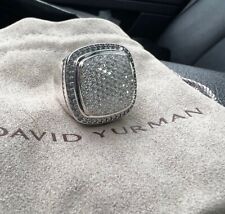
David Yurman Sterling Silver 20mm Albion pave Diamond Ring Size 7 $489.00
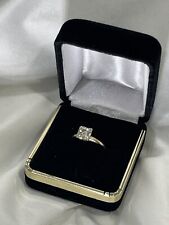
Vintage 14kt Gold Natural Diamond Engagement/Wedding Ring Sz: 6 - c1950 $350.00
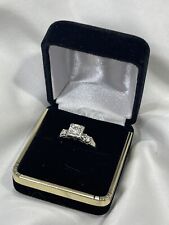
Vintage 14kt White Gold Natural Diamond Engagement/Wedding Ring Sz: 7 - c1950 $715.00
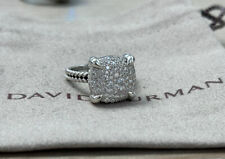
DAVID YURMAN STERLING SILVER 925 14MM CHATELAINE PAVE DIAMOND RING SIZE 6 $339.00
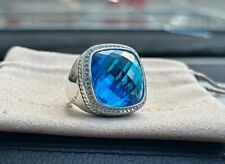
David Yurman Albion 925 Silver 20mm Albion Blue Topaz & Diamond Ring Sz 7 $259.00
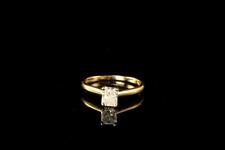
VINTAGE SHANE CO DIAMOND 14K YELLOW GOLD ENGAGEMENT SIMPLE RING EJP $285.00
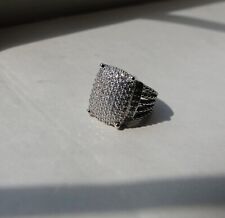
David Yurman Sterling Silver 925 Wheaton Pave Diamonds Ring 16x12mm Size 7 $290.00
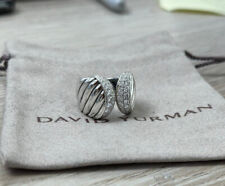
David Yurman Sterling Silver 925 Sculpted Cable Pave Diamond Ring Size 7 $265.00
|